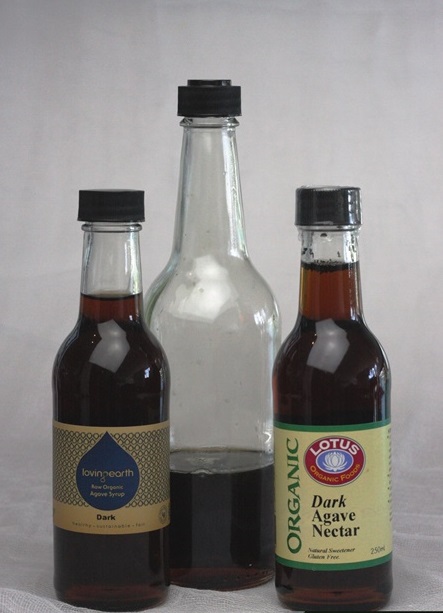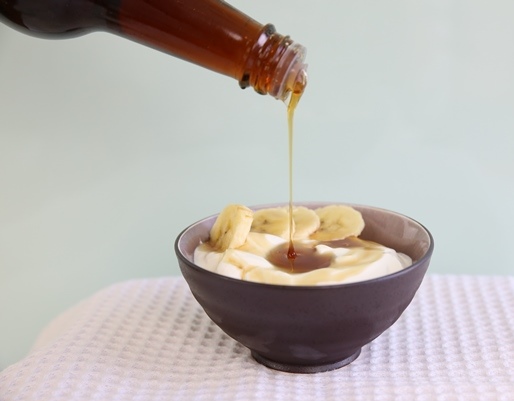- Home
- Blog
- Carbs, Sugars and Fibres
- Agave – is it better than sugar?
Agave – is it better than sugar?
Written by Catherine Saxelby
on Monday, 09 December 2013.
Tagged: carbohydrates, carbs, cravings, diabetes, Healthy eating, honey, sugar, sugar substitutes, sweetener

Agave syrup has been consumed for thousands of years in Mexico and Central America, but has only recently risen to fame as an alternative sweetener. Practically unheard of ten years ago, it is now a popular item in health food stores and whole food cafés. I first spotted it on the breakfast menu at a whole food cafe drizzled over buckwheat pancakes with blueberries, raw cacao and yoghurt. So it was time to investigate if agave really is better for me?
Where does agave come from?
Agave (which I prefer to call agave syrup, not nectar, as it's very like maple syrup) is produced from the blue agave succulent plant (sp Agave ) in Mexico. Agaves are large, spikey plants that resemble cactus but they are actually related to the aloes such as Aloe vera.
Due to its high content of natural carbohydrates including inulin and sugars (which is where the original term nectar came from), blue agave is the preferred species for producing the syrup. This is a different agave species from that used as the basis for tequila.
How is agave made

Bear in mind to extract its sweetness and allow it to keep indefinitely on a shelf without refrigeration, its manufacture requires an intensive, industrial process. I don't see how that can be called 'natural' in any shape or form. In fact the word "processed" leaps to mind.
Certainly the agave plants are grown organically and the whole growing procedure can be sustainable but it's not natural and it's not local. Here in Australia you'd be buying local if you went for golden syrup or honey - not a product that's been shipped all the way from Mexico.
Agave's taste
I've read that you can buy three types: light, amber and dark but I've only been able to buy the dark syrup so I'll limit my comments to that.
The lighter syrups undergo less heating and a more thorough filtration to produce a milder product – suitable for use in recipes. The darker syrups are filtered less, and the solids left in the syrup make for a stronger nectar.
Personally I enjoy the taste of the darker agave. It tastes like honey with overtones of caramel and burnt sugar. I found it runnier than honey with a similar viscosity and colour to maple syrup. It was divine drizzled over my morning oats or with yoghurt and diced pear and banana.
I found agave too runny to spread on toast. With its thinner consistency, I can see it featuring as an ingredient in salad dressings and in iced tea or home-made fruit cordials as it dissolves more quickly in liquids than honey and doesn't crystallise on standing.
Nutrition in agave
Like other syrups, agave has around 74 per cent total sugars and no starch or fat or protein. One tablespoon of agave syrup supplies around 265 kJ (or 63 Calories) and 16 g carbs. You still have to count one spoon as one carb exchange if you have diabetes.
- Compared to sugar or golden syrup, it's great difference is that it is high in fructose which gives it a very low Glycemic Index (GI) of 15 which is much lower than that of other sugars. This means that it doesn't raise your blood glucose levels as quickly as sugar 65 or honey 50.
- In agave, the ratio of fructose to glucose is roughly 75 per cent fructose to 25 per cent glucose, which is higher than refined sugar which is a mix of 50 per cent fructose with the rest 50 per cent glucose.
- Not everyone finds the high fructose content in agave desirable. Some people have trouble absorbing fructose, so eating lots of it can cause bloating, gas and abdominal discomfort. So agave can be especially problematic for people with irritable bowel syndrome (IBS) or sensitive guts.
If you're vegan, you'll find agave is commonly used as an alternative to honey, as it is made from a plant.
Being refined, there are few vitamins, minerals or antioxidants so it really doesn't appear to be inherently healthier than refined sugar. According to a 2009 Oslo sweetener study, agave had one of the poorest antioxidant values of the 14 alternative sweeteners tested.
However it does contain fewer kilojoules than honey or maple syrup but more than blackstrap molasses and definitely fewer than sugar but it's only a minor difference.
Nutrition stats
Per serve:
One tablespoon (20 ml) supplies 265 kJ (63 Calories), no protein, no fat and 16 g of carbohydrate, 14 g of sugars, 11 g fructose and 3 g glucose.
Per 100 g:
1300 kJ (310 Calories), no protein, no fat and 77 g of carbohydrate, 74 g of sugars, 56 g fructose and 19 g glucose.
The bottom line
Should you switch to agave? Is it healthier than sugar? Not really. Compared to sugar, honey or maple syrup, the nutritional differences are negligible so just choose whichever one you prefer.
It's not on a par with honey or maple syrup as it has fewer minerals and fewer antioxidants. To me it's a pleasant sweetening agent – I do like its rich caramel undertones - but nothing startling.
If you just have a tablespoon or two a day, say over pancakes, it's fine in that quantity. But don't use agave as an excuse to get more sweet stuff into your diet just because it has a lower Glycemic Index. Most of us consume far more sugar in all forms than we should. We need less, not more.
You may also be interested in...
Foodwatch
The Good Stuff
The Boring Stuff
© 2025 Foodwatch Australia. All rights reserved
Website by Joomstore eCommerce










